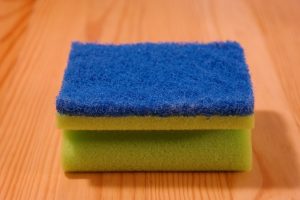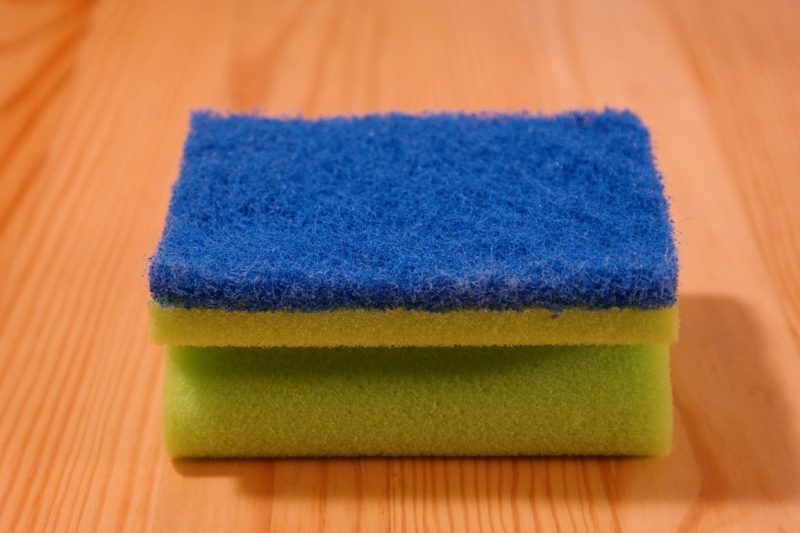 A lot of people just assume that because you use soap on a sponge, it’s clean.
A lot of people just assume that because you use soap on a sponge, it’s clean.
While it’s true that soap does kill bacteria, it doesn’t get all of the embedded bacteria that can live inside the sponge.
A dirty sponge is a detriment to your kitchen, and can often leave dishes that you would think are clean, with a hidden danger on them.
You would think your sponge is the cleanest thing in the kitchen, considering how often it comes into contact with soap and other harsh chemicals.
Surely bacteria wouldn’t be able to survive all the soap and hot water that’s usually around a sponge, right? Well, as it turns out, that just isn’t the case.
A sponge, something that’s supposed to improve your hygiene, can actually be a detriment to your health.
With something you use as often as sponge, you should be careful.
Disease in your sponge
In a study from a joint University team in Germany, they used laser analysis to determine the bacterial composition found inside your average kitchen sponge.
Even in sponges that were “cleaned’, they found not one, not two, but 362 different kinds of bacteria in a single sponge alone.
Five out of ten of the most frequent bacteria strains they found have disease causing potential.
But it’s not just the common cold, or anything mundane.
Sure, things like the flu and rhinovirus are found inside sponges all the time, but there’s more dangerous kinds of bacteria that we need to be aware of.
Found by a study by infection specialists at the King’s College in London, up to seven percent of sponges can harbor the anti-biotic resistant staphylococcus aureus, also known as flesh eating bacteria.
If that’s not reason enough to regularly disinfect and replace your sponge, I don’t know what is.
Not only disease causing bacteria can be harbored in sponges, often there can be bacterial infections that make you sponge smell bad, and degrade over time as it eats the sponge.
Moraxella osloensis is one such bacteria. It loves to live inside sponges, and as it grows, it makes the sponge smell bad, and eats away at its insides.
So if you’ve ever wondered why your sponge or other kitchen cleaning elements smell awful, that might be the reason why.
The inside of the sponge is the perfect incubation chamber for bacteria.
That’s why so many kinds of dangerous bacteria, that wouldn’t ordinarily be able to survive, can be found inside of a sponge.
Wet, full of food particles, and often away from the harsh chemicals that might contact the outside of the sponge.
This provides the perfect breeding ground for bacteria to survive and collect inside of.
With all these things, it’s no wonder that researchers find so many kinds of dangerous bacteria inside of it.
We all know the dangers of exposure to bacteria. Flus, colds, and everything else.
I don’t think anyone needs to be told to wash their hands regularly, but how many of us wash our sponges?
I’m sure some of us might wash some of the gunk and debris off of them, but that’s not enough.
Just because you make it look clean, doesn’t mean the sponge is actually clean.
Deep inside the sponge, dangerous bacteria can still lurk, outside of our vision.
Properly cleaning your sponge
So what can we do to actually clean the sponges to a sterile state? There’s two things that kill bacteria most effectively, heat and chemicals.
The best thing that we can use in the kitchen is heat, and it’s by far the most accessible to us.
Well, one of the easiest ways you can do this is just by microwaving the sponge. First, be sure to get it nice and wet, but not too soaking.
Wring it out a bit and leave some moisture inside the sponge.
This will make sure there’s plenty of steam in it, when it reaches a decent temperature.
Just put it in the microwave for a few minutes, and that will kill all the bacteria inside of it.
I know that seems like a long time, but don’t worry. You won’t do any permanent damage to the sponge.
It’ll be really hot, so be careful you don’t burn yourself when you take it out!
Another good method is putting the sponge inside of your dishwasher.
There is pretty similar to the microwave method, except it’s a bit more intensive.
Dishwashers are extremely hot, in order to not only get the grime off the dishes, but kill bacteria as well. This will work perfectly for our sponge.
Find a nice spot for it, preferably on the top, where the heat at the bottom won’t melt the sponge.
As well, make sure it’s in a good position, you don’t want the sponge falling through the cracks into the bottom of the dishwasher.
After a long cleaning cycle, the sponge will surely have the bacteria boiled out of it.
Now, the common factor between all these cleaning methods is heat.
Boiling water, or steam that cleans out the sponge, cleaning the bacteria.
However, there are strains of bacteria that are resistant to heat, and as such these methods are not one hundred percent foolproof.
Despite the good that boiling your sponges might do, it’s always better to replace your sponge when you can.
With sponges being as cheap as they are, there’s no reason to gamble with your health over a dollar sponge.
Just simply toss it out and replace it with a fresh one. Your dishes, and your body, will thank you for it.
Researchers recommend you replace your sponge once a week, that way there won’t be any time for bacterial colonies to achieve any significant growth inside of your sponge.
With a combination of properly cleaning your sponge, and being sure to replace it with a new one, you’re sure to have a healthy kitchen.
If you don’t remember anything else, just remember to replace your sponge every week!
Besides kitchen sponge bacteria, there are more than thousands of toxic chemicals in many of the food and products you eat or use every day and they can increase your risk of diseases and even the big C..
Go to the next page and & learn how you can protect your body from these deadly toxins –
About the Author:
Emma Deangela is the best selling author of The Alkaline Diet Program and 80/20 Fat Loss. She has helped over tens of thousands of men and women to lose weight and transform their health with sound nutrition advice. Learn how you can lose weight fast – How to lose weight by adding these alkaline foods.
Are you concerned about the harmful bacteria in your kitchen sponge?
Please share with your friends this article on the Kitchen Sponge – Use any of the social media and email buttons on the left of our website.


Leave a Reply